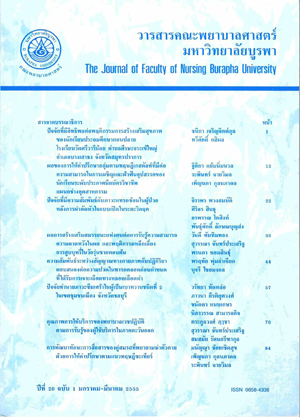ปัจจัยที่มีความสัมพันธ์กับภาวะแทรกซ้อน ในผู้ป่วยหลังการผ่าตัดหัวใจแบบเปิดในระยะวิกฤต
คำสำคัญ:
ภาวะแทรกซ้อนในผู้ป่วยหลังผ่าตัดหัวใจแบบเปิด, ระยะวิกฤต, ระยะเวลาใช้เครื่องหัวใจ-ปอดเทียม, Complications in postoperative open heart surgery patients, critical period, cardiopulmonary bypass timeบทคัดย่อ
การวิจัยครั้งนี้เป็นการศึกษาเชิงบรรยายเพื่อศึกษาความสัมพันธ์ระหว่างอายุ ภาวะโรคร่วม อัตราส่วนร้อยละของปริมาณเลือดที่บีบออกจากหัวใจ ระยะเวลาใช้เครื่องหัวใจ-ปอดเทียมกับภาวะแทรกซ้อนในผู้ป่วยหลังผ่าตัดหัวใจแบบเปิดในระยะวิกฤต กลุ่มตัวอย่างคือ ผู้ป่วยที่เข้ารับการรักษาโดยการผ่าตัดหัวใจแบบเปิดทั้งเพศชายและเพศหญิงที่เข้ารับการรักษาในโรงพยาบาลระดับตติยภูมิจำนวน 88 ราย เลือกกลุ่มตัวอย่างแบบสะดวก (convenience sampling) ตามคุณสมบัติที่กำหนด เก็บข้อมูลระหว่างเดือนกันยายน 2553 ถึง พฤศจิกายน 2553 โดยใช้แบบบันทึกข้อมูลส่วนบุคคล แบบประเมินโรคร่วม และแบบประเมินภาวะแทรกซ้อนในระยะวิกฤต นำแบบประเมินภาวะแทรกซ้อนในระยะวิกฤตตรวจสอบความตรงตามเนื้อหา (content validity index : CVI) ได้ค่าเท่ากับ 0.87 วิเคราะห์ข้อมูลโดยใช้สถิติเชิงบรรยาย และวิเคราะห์ความสัมพันธ์ระหว่างตัวแปรที่ศึกษาโดยใช้สถิติสัมประสิทธิ์สหสัมพันธ์สเปียร์แมน ผลการศึกษาพบว่ากลุ่มตัวอย่างเป็นเพศชายร้อยละ 61.40 อายุเฉลี่ย 63.90 ปี (SD 13.36) โรคร่วมที่พบมากที่สุดคือ เบาหวาน (42.00%) อัตราส่วนร้อยละของปริมาณเลือดที่บีบออกจากหัวใจโดยเฉลี่ย 54.80 % (SD 16.40) กลุ่มตัวอย่างมีระยะเวลาใช้เครื่องหัวใจและปอดเทียมเฉลี่ย 105 นาที (SD 9.70) และภาวะแทรกซ้อนภายหลังผ่าตัดที่พบมากที่สุด ภาวะหัวใจเต้นผิดจังหวะ ปัจจัยที่มีความสัมพันธ์กับภาวะแทรกซ้อนในผู้ป่วยหลังการผ่าตัดหัวใจแบบเปิดในระยะวิกฤตอย่างมีนัยสำคัญทางสถิติ ได้แก่ อายุ (r = 0.29, p < .01) อัตราส่วนร้อยละของปริมาณเลือดที่บีบออกจากหัวใจ (r = -0.43, p < .01) ภาวะโรคร่วม (r = 0.44, p < .01) และระยะเวลาใช้เครื่องหัวใจ-ปอดเทียม (r = 0.37, p < .01)
จากการศึกษามีข้อเสนอแนะว่าการปฏิบัติการพยาบาลในผู้ป่วยหลังผ่าตัดหัวใจแบบเปิด พยาบาลควรคำนึงถึง อายุ อัตราส่วนร้อยละของปริมาณเลือดที่บีบออกจากหัวใจ ภาวะโรคร่วม และระยะเวลาใช้เครื่องหัวใจและปอดเพื่อเป็นการเฝ้าระวังและป้องกันภาวะแทรกซ้อนที่จะเกิดขึ้น
This study was a descriptive research design aimed at examining the correlations between age, comorbidities, ejection fraction (EF), cardiopulmonary bypass time (CBP time), and complications in postoperative open heart surgery patients during the critical period. The sample was comprised of 88 male and female patients, who had been admitted for open heart surgery and treatment at a tertiary hospital. The sample was selected by convenience sampling according to qualifications. Data collection took place from September to November of 2010 and data was collected by using demographic data record forms, a comorbidity assessment form, and a critical period complication evaluation form. A critical period complication evaluation form was submitted to content validity index (CVI) testing whereby the CVI was obtained at 0.87. The data was analyzed by using descriptive statistics and by analyzing the correlations between the variables studied by using Spearman’s Rank Correlation Coefficient.
The research findings showed the majority of the samples were male (61.40%) with a mean age of 63.90 years (SD 13.36). The comorbidities most frequently encountered were diabetes (42.00%), and ejection fraction at a mean of 54.80% (SD 16.40). The sample group had a mean CBP time of 105 minutes (SD 9.70), and the most frequently encountered complications in postoperative open heart surgery patients during the critical period was cardiac arrhythmia. The factors correlated with complications in postoperative open heart surgery patients during the critical period with statistical significance were found to be age
(r = 0.29, p < .01), EF (r = -0.43, p < .01), comorbidities
(r = 0.44, p < .01) and CPB times (r = 0.37, p < .01).
The findings of this study recommend that nursing practice for postoperative open heart surgery patients take age, EF, comorbidities, and CBP times into consideration in order to monitor and prevent potential complications in this group of patients





